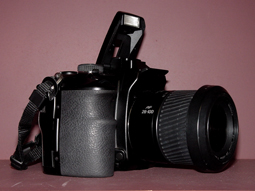DSLRs: Cameras for all occasions
- November 7, 2006
- |
- Matt Cook, Technical Editor
- Section: Technology
When exploring the market for digital single-lens reflex cameras, inexperienced buyers often look at only two categories to influence their decision making process: megapixels and price. There is a lot to be said about the potential size and relative clarity a picture is capable of from the number of megapixels in a camera, and certainly price is a huge factor for college aged photo enthusiasts. There are, however, literally hundreds of options in today’s DSLRs that one must consider before making the best choice.
One in the market for a DSLR must consider not the specifications of the camera as a whole, but as two separate parts: body and lens (or lenses). Naturally, then, the process of buying a DSLR can be daunting and take months if waiting for the price to drop, but in the end the pictures a single-lens reflex camera can take will outperform those of a compact digital camera nine times out of ten.
The cameras below are reviewed based largely on their body specifications. So many lenses are available for each camera that covering them would take days. However, if the manufacturer lists a specific lens that is sold with the body as a “kit” then it will be noted.
Olympus Evolt E-330
The Olympus Evolt E-330 is an exciting camera that has been out since Spring 2006 and comes with several fun features that are unique among DSLRs. The E-330 has a 2.5 inch swivel LCD screen, similar to those seen on numerous compact models. In addition, users no longer have to use the viewfinder to frame up their shot: the E-330 is the first DSLR to have that capability in its LCD. All cameras in the Evolt line feature a dust prevention system that shakes the sensor to remove the build up of dust that over time can add spots to images.
The E-300 has 29 shooting modes – 20 predefined and nine manual settings. It supports CompactFlash Type I and II and xD Picture Cards to allow users a choice of flash storage of JPEG, TIFF or RAW files.
The E-330 has only 7.5 megapixels and three auto focus points (most DSLRs have at least 5 AF points), which makes it an entry level camera. As one can expect in an entry level, the built in flash is less than perfect and start up time, 1.9 seconds, is less than desirable. It is also a bit pricey for an entry level DSLR: $1,000 with a Zuiko Digital 14-45 mm zoom lens.
Canon Digital Rebel XTi
The Canon Digital Rebel XTi follows up on the heels of its predecessor, the six megapixel Rebel XT released last year that changed the way DSLRs were thought about with its $600 retail price. The XTi features 10.1 megapixels which produces in effect an image 3,904 x 2,598 pixels. For any photographer considering printing (and few photographers do not think of printing at some point) the 10.1 megapixels XTi is a dream for prints. The 2.5 inch LCD has a 160 degree viewing angle and has a sensor that turns the LCD off when the photographer’s face gets close.
As far as the technical details, start up time is a miniscule .2 seconds and time between shots is .8 seconds. The XTi has a nine point auto focus system, six preset and three custom “Picture Style” settings that allow photographers to shoot different styles that imitate different types of film. The XTi features a dust removal system similar to the Olympus E-330. All of these features and an 18-55mm kit lens retail for just over $700, but a better Canon lens, instead of the $100 kit lens, can be purchased for around $400.
Nikon D80
The Nikon D80 is viewed by many as a cross between the Nikon consumer cameras D50 and D70 and the more professional D200 and D2X line. It is one of the most recent DSLRs to hit the market, released about two months ago and it does not disappoint. The 10 megapixel camera has an 11 point auto focus system, seven preset and four manual settings for shooting in various situations. The 2.5 LCD screen displays shots with accurate color and detail and has a 170 degree viewing angle.
The start up and recharge times are virtually the same as the Canon XTi: .6 seconds for both. Also available to accompany the D80 is the entire line of Nikor Digital SLR lenses. These vary from specialty wide lenses to super zooms to everything in between. The D80 kit comes with an 18-135mm Auto Focus, Silent Wave Motor Nikor Lens for a slightly pricey $1,300. Combining the body with another Nikor lens may be most desirable for professional photographers.
